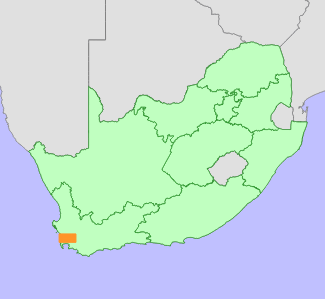|
Scientific Name | Muraltia decipiens Schltr. |
Higher Classification | Dicotyledons |
Family | POLYGALACEAE |
National Status |
Status and Criteria | Endangered B1ab(i,ii,iii,iv,v); C2a(i) |
Assessment Date | 2015/05/11 |
Assessor(s) | N.A. Helme, D. Raimondo, D. van der Colff & L. von Staden |
Justification | About nine small, severely fragmented subpopulations remain within a small area (EOO 2238 km²) after more than 80% habitat loss. The remaining population is small, estimated to number fewer than 600 mature individuals, with the largest subpopulation consisting of between 100 and 200 mature individuals, and continues to decline due to ongoing habitat loss and degradation. |
Distribution |
Endemism | South African endemic |
Provincial distribution | Western Cape |
Range | Mamre to Wellington, Franschhoek and the Cape Flats. |
Habitat and Ecology |
Major system | Terrestrial |
Major habitats | Swartland Shale Renosterveld, Swartland Granite Renosterveld, Hawequas Sandstone Fynbos, Boland Granite Fynbos, Cape Flats Sand Fynbos, Atlantis Sand Fynbos, Swartland Alluvium Fynbos |
Description | Clay flats and lower slopes. |
Threats |
| This species has already lost around 80% of its lowland habitat, predominantly to urban expansion on the Cape Flats, timber plantations on the lower mountain slopes around Franschhoek, and agricultural expansion between Atlantis, Paarl and Wellington, and in the Berg River Valley between Franschhoek and Paarl. Remaining subpopulations continue to be threatened by habitat loss to urban and agricultural expansion, inappropriate fire management, and competition from unmanaged alien invasive plants. |
Population |
Less than 20% of this range-restricted lowland species' habitat remains intact. Field surveys of remaining habitat indicate that there are about nine surviving subpopulations, and all are small, the largest consisting of 100-200 mature individuals, and all occur on isolated fragments of natural vegetation. This species is a short-distance disperser (Forest et al. 2007), and dispersal between remaining habitat patches is unlikely. The population size is estimated to be less than 600 mature individuals, and continues to decline.
|
Population trend | Decreasing |
Assessment History |
Taxon assessed |
Status and Criteria |
Citation/Red List version | | Muraltia decipiens Schltr. | EN B1ab(ii,iii,v) | Raimondo et al. (2009) | |
Bibliography |
Forest, F., Chase, M.W., Persson, C., Crane, P.R. and Hawkins, J.A. 2007. The role of biotic and abiotic factors in evolution of ant dispersal in the milkwort family (Polygalaceae). Evolution 61(7):1675-1694.
Goldblatt, P. and Manning, J.C. 2000. Cape Plants: A conspectus of the Cape Flora of South Africa. Strelitzia 9. National Botanical Institute, Cape Town.
Levyns, M.R. 1954. The genus Muraltia. Journal of South African Botany Supplement 2:1-247.
Raimondo, D., von Staden, L., Foden, W., Victor, J.E., Helme, N.A., Turner, R.C., Kamundi, D.A. and Manyama, P.A. 2009. Red List of South African Plants. Strelitzia 25. South African National Biodiversity Institute, Pretoria.
|
Citation |
| Helme, N.A., Raimondo, D., van der Colff, D. & von Staden, L. 2015. Muraltia decipiens Schltr. National Assessment: Red List of South African Plants version 2024.1. Accessed on 2025/11/05 |
 Comment on this assessment
Comment on this assessment


